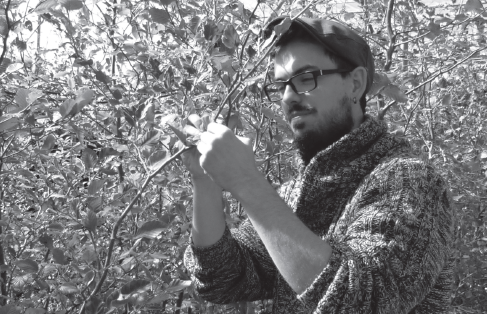FOREST BIOLOGY
How do trees die?
Doctoral school : RP2E — Science and Engineering, Processes, Resources, Products, Environment
Research topic : Study of the sensitivity of Lorraine populations of beech in response to climatic events — What roles does carbon and nitrogen metabolism play in the death of trees?
__________________________________________________________________________________________
Pierre-Antoine Chuste is a young researcher in forest biology at the French National Institute for Agricultural Research currently working in a laboratory which studies how forests are impacted by climate change. Pierre-Antoine specifically focuses on understanding how trees die when subjected to drought events. His goal is to help professionals in the forestry sector effectively predict how forests will change when subjected to climatic changes.
* A drought event is defined by the lack of precipitation during a given period.
“Being a researcher means you make your living by being curious. Earning a doctoral degree in forest biology means you get to work with trees. And since we wouldn’t be here without trees, why not try to understand them better and protect them by every means possible?”
Climate change and drought events will occur in the future not only more frequently, but with more intensity. We will not be able to simply ‘water’ the forests like we can with parks or gardens. This is why forests are at risk. It’s one thing knowing that trees will die as a result of extreme drought, but saving them requires a thorough understanding of how trees die. Just like for you and me, trees need more than just water taken from the soil with through its roots, but also nutrients or food which comes principally from its leaves in a process that relies on sunlight and carbon dioxide (CO2). In the event of drought, a tree is deprived of water and it’s reserves become depleted. The question becomes, if this tree dies, has it died as a result of thirst or of hunger?
It is this very question that Pierre-Antoine is attempting to answer through his research by focusing on a species widely found in forests in Lorraine: beech. To do this, he is participating in a large scale experiment which involves some 10 year old 1,000 beech trees growing under a roof which intercepts rainfall and effectively mimics the effects of drought. Certain beech trees are selected to receive no water at all, others are provided with normal water supplies but are partially defoliated. These treatments diminish the trees’ natural reserves. Other beech trees within the same experiment are watered but not defoliated. Pierre-Antoine compares these beech trees growing under these varying conditions. He investigates general changes in the overall health of the trees, for example, changes in growth patterns. He also looks for specific properties that may ensure a tree’s survival during drought, while in the same conditions, another tree will die.
One year after the launch of this experiment, Pierre-Antoine was able to see that the beech trees that had been defoliated continued to grow the following year. Does this mean that trees do not actually suffer when their leaves are removed? Or does this mean that to survive, trees draw more heavily on their reserves at the risk of becoming more fragile in the future?
* to defoliate : to remove leaves from a tree
Objectives / Applications —
- To determine if beech trees will become more sensitive to future climatic changes.
- To provide answers for professional forest managers in order to help them prepare the best way possible for global warming.



